Numerical Analysis of Conjugated Heat Transfer and Thermal Stress Distributions in a High-Temperature Ni-Based Superalloy Turbine Rotor Blade
Abstract
:1. Introduction
2. Numerical Method
2.1. Governing Equations of the Thermal Fluid–Solid Coupling
2.2. Crystal Plasticity Finite Element Simulation Method
2.3. Dominant Slip Systems
3. Numerical Simulation Procedure
3.1. Numerical Model for Fluid Domain
3.1.1. Geometric Model
3.1.2. Boundary Conditions
3.1.3. Meshing and Grid Independence Verification
3.2. Numerical Model for Solid Domain
3.2.1. Material Parameters
3.2.2. Meshing and Grid Independence Verification
4. Results and Discussion
4.1. Flow Field Analysis
4.2. Heat Transfer Analysis
4.3. Thermal Stress Analysis
5. Conclusions
- The inherent forces (Coriolis, centrifugal, and buoyancy forces) of rotation deflect the coolant flow to a specific wall and induce the generation of secondary flow, which increases the complexity of the vortex structure in the cooling channels of the rotor blade, differentiated from the stationary condition. Simultaneously, the coolant turbulence is enhanced; thus, the heat transfer performance of the rotor blade is improved with higher overall cooling efficiency under the rotating condition. The maximum temperature of the blade under the rotating condition is reduced by 5% compared with that under the stationary condition. Therefore, the highest temperature of the blade will satisfy the design requirements under the rotating condition if these design requirements are met under the stationary condition.
- The von Mises stress concentrations locate where the blade root connects to the hub and the film holes near the leading-edge region of the blade root and the mid-chord of the grooved blade tip under the two conditions. However, the maximum magnitude of the von Mises stress of the rotor blade under the rotating condition reduces by 21% compared with that under the stationary condition. The thermal stress distribution on the blade suction surface is more uniform under the rotating condition than under the stationary condition. On the basis that the rotor blade meets the highest temperature design requirements, the thermal stress distribution of the blade in conjunction with the high-temperature gradient regions under the rotating condition is better than that under stationary conditions.
- The maximum value of the MRSS regions does not entirely correspond to the von Mises stress concentration regions under rotating and stationary conditions. The positive and negative striped values of MRSS appear alternately on the blade surface, on which the MRSS distribution is more inhomogeneous than the von Mises stress under both conditions. The dominant slip system of the rotor blade is the dodecahedral slip family (<112>) under both conditions. Compared with the von Mises stress results, the mid-chord of the suction surface also deserves attention for the larger MRSS and interface of different dominant slip systems under both conditions, especially under the stationary condition.
Author Contributions
Funding
Institutional Review Board Statement
Informed Consent Statement
Data Availability Statement
Conflicts of Interest
Abbreviations
| C3D4 | Four-node linear tetrahedral element |
| CHT | Conjugate heat transfer |
| CPFEM | Crystal plasticity finite element simulation method |
| DS | Directionally solidified |
| DSS | Dominant slip system |
| MRSS | Maximum resolved shear stress |
| RSS | Resolved shear stress |
References
- Han, J.-C. Advanced cooling in gas turbines 2016 Max Jakob memorial award paper. J. Heat Transf. 2018, 140, 113001. [Google Scholar] [CrossRef]
- Wagner, J.; Johnson, B.; Kopper, F. Heat transfer in rotating serpentine passages with smooth walls. J. Turbomach. 1991, 113, 321–330. [Google Scholar] [CrossRef]
- Wagner, J.; Johnson, B.; Graziani, R.; Yeh, F. Heat transfer in rotating serpentine passages with trips normal to the flow. J. Turbomach. 1992, 114, 847–857. [Google Scholar] [CrossRef]
- Al-Qahtani, M.; Jang, Y.-J.; Chen, H.-C.; Han, J.-C. Prediction of flow and heat transfer in rotating two-pass rectangular channels with 45-deg rib turbulators . J. Turbomach. 2002, 124, 242–250. [Google Scholar] [CrossRef]
- Dutta, S.; Han, J.-C. Local heat transfer in rotating smooth and ribbed two-pass square channels with three channel orientations. J. Heat Transfer. 1996, 118, 578–584. [Google Scholar] [CrossRef]
- Al-Hadhrami, L.; Han, J.-C. Effect of rotation on heat transfer in two-pass square channels with five different orientations of 45 angled rib turbulators. Int. J. Heat Mass Transf. 2003, 46, 653–669. [Google Scholar] [CrossRef]
- Parsons, J.A.; Han, J.-C. Rotation effect on jet impingement heat transfer in smooth rectangular channels with heated target walls and radially outward cross flow. Int. J. Heat Mass Transf. 1998, 41, 2059–2071. [Google Scholar] [CrossRef]
- Wright, L.M.; Lee, E.; Han, J.-C. Effect of rotation on heat transfer in rectangular channels with pin-fins. J. Thermophys. Heat Transf. 2004, 18, 263–272. [Google Scholar] [CrossRef]
- Griffith, T.S.; Al-Hadhrami, L.; Han, J.-C. Heat transfer in rotating rectangular cooling channels AR = 4 with dimples. J. Turbomach. 2003, 125, 555–563. [Google Scholar] [CrossRef]
- Ahn, J.; Schobeiri, M.; Han, J.-C.; Moon, H.-K. Film cooling effectiveness on the leading edge region of a rotating turbine blade with two rows of film cooling holes using pressure sensitive paint. J. Heat Transf. 2006, 128, 879–888. [Google Scholar] [CrossRef]
- Rezasoltani, M.; Lu, K.; Schobeiri, M.T.; Han, J.-C. A combined experimental and numerical study of the turbine blade tip film cooling effectiveness under rotation condition. J. Turbomach. 2015, 137, 051009. [Google Scholar] [CrossRef]
- Rezasoltani, M.; Schobeiri, M.; Han, J. Experimental investigation of the effect of purge flow on film cooling effectiveness on a rotating turbine with non-axisymmetric endwall contouring. In Turbo Expo: Power for Land, Sea, and Air; American Society of Mechanical Engineers: New York, NY, USA, 2013; Volume 55157, p. V03BT13A033. [Google Scholar]
- Yeranee, K.; Yu, R. A review of recent studies on rotating internal cooling for gas turbine blades. Chin. J. Aeronaut. 2021, 34, 85–113. [Google Scholar] [CrossRef]
- Rao, V.N.B.; Kumar, I.N.; Prasad, K.B. Failure analysis of gas turbine blades in a gas turbine engine used for marine applications. Int. J. Eng. Sci. Technol. 2014, 6, 43–48. [Google Scholar]
- Kim, K.M.; Park, J.S.; Lee, D.H.; Lee, T.W.; Cho, H.H. Analysis of conjugated heat transfer, stress and failure in a gas turbine blade with circular cooling passages. Eng. Fail. Anal. 2011, 18, 1212–1222. [Google Scholar] [CrossRef]
- Ziaei-Asl, A.; Ramezanlou, M.T. Thermo-mechanical behavior of gas turbine blade equipped with cooling ducts and protective coating with different thicknesses. Int. J. Mech. Sci. 2019, 150, 656–664. [Google Scholar] [CrossRef]
- Staroselsky, A.; Martin, T.; Cassenti, B. Transient thermal analysis and viscoplastic damage model for life prediction of turbine components. J. Eng. Gas Turbines Power 2015, 137, 042501. [Google Scholar] [CrossRef]
- Wang, J.; Wei, D.; Wang, Y.; Jiang, X. A fatigue life prediction model based on modified resolved shear stress for nickel-based single crystal superalloys. Metals 2019, 9, 180. [Google Scholar] [CrossRef] [Green Version]
- Hou, N.; Wen, Z.; Yu, Q.; Yue, Z. Application of a combined high and low cycle fatigue life model on life prediction of SC blade. Int. J. Fatigue 2009, 31, 616–619. [Google Scholar] [CrossRef]
- Hou, N.; Gou, W.; Wen, Z.; Yue, Z. The influence of crystal orientations on fatigue life of single crystal cooled turbine blade. Mater. Sci. Eng. A 2008, 492, 413–418. [Google Scholar] [CrossRef]
- Wen, Z.; Hou, N.; Wang, B.; Yue, Z. Crystallographic life model for single crystal turbine blade and validation by the miniature specimens cut from the turbine blades. Multidiscip. Model. Mater. Struct. 2010, 6, 508–529. [Google Scholar] [CrossRef]
- Liu, Z.; Yue, Z.; Zhi, X.; Hou, N. Influence of dimension variation on strength and fatigue life of single crystal cooled blade. Rare Met. Mater. Eng. 2013, 42, 1563–1567. [Google Scholar]
- Hou, N.; Yu, Q.; Wang, B.; Yue, Z. An equivalent model for mechanical analysis of single crystal cooled blade with film cooling holes using crystal plasticity. Eng. Fract. Mech. 2010, 77, 1379–1385. [Google Scholar] [CrossRef]
- Arakere, N.; Siddiqui, S.; Ebrahimi, F. Evolution of plasticity in notched Ni-base superalloy single crystals. Int. J. Solids Struct. 2009, 46, 3027–3044. [Google Scholar] [CrossRef] [Green Version]
- Mao, H.; Wen, Z.; Yue, Z.; Wang, B. The evolution of plasticity for nickel-base single crystal cooled blade with film cooling holes. Mater. Sci. Eng. A 2013, 587, 79–84. [Google Scholar] [CrossRef]
- John, B.; Senthilkumar, P.; Sadasivan, S. Applied and theoretical aspects of conjugate heat transfer analysis: A review. Arch. Comput. Methods Eng. 2019, 26, 475–489. [Google Scholar] [CrossRef]
- Dong, P.; Wang, Q.; Guo, Z.; Huang, H.; Feng, G. Conjugate calculation of gas turbine vanes cooled with leading edge films. Chin. J. Aeronaut. 2009, 22, 145–152. [Google Scholar] [CrossRef] [Green Version]
- ANSYS. ANSYS CFX-Solver Modeling Guide; ANSYS: Canonsburg, PA, USA, 2020. [Google Scholar]
- Roters, F.; Eisenlohr, P.; Hantcherli, L.; Tjahjanto, D.D.; Bieler, T.R.; Raabe, D. Overview of constitutive laws, kinematics, homogenization and multiscale methods in crystal plasticity finite-element modeling: Theory, experiments, applications. Acta Mater. 2010, 58, 1152–1211. [Google Scholar] [CrossRef]
- Li, Z.; Gao, H.; Wen, Z.; Yang, Y.; Zhang, Y.; Ai, X.; Yue, Z. Microcrack initiation behavior around film cooling holes in a Ni-based single crystal: In situ observation and crystal plastic analysis. Mater. Sci. Eng. A 2020, 771, 138609. [Google Scholar] [CrossRef]
- Shenoy, M.M. Constitutive Modeling and Life Prediction in Nickel-Base Superalloys; Georgia Institute of Technology: Atlanta, Georgia, 2006. [Google Scholar]
- Cai, L.; He, Y.; Wang, S.; Li, Y.; Li, F. Thermal-Fluid-Solid coupling analysis on the temperature and thermal stress field of a Nickel-Base superalloy turbine blade. Materials 2021, 14, 3315. [Google Scholar] [CrossRef]
- Stewart, C. Tertiary Creep Damage Modeling of a Transversely Isotropic Ni-Based Superalloy. Master’s Thesis, University of Central Florida, Orlando, FL, USA, 2009. [Google Scholar]
- Zhai, Y.; Khan, M.K.; Correia, J.; deJesus, A.M.; Huang, Z.; Zhang, X.; Wang, Q. Effect of secondary crystal orientations on the deformation anisotropy for nickel-based single-crystal plate with notch feature. J. Strain Anal. Eng. Des. 2019, 54, 54–64. [Google Scholar] [CrossRef]

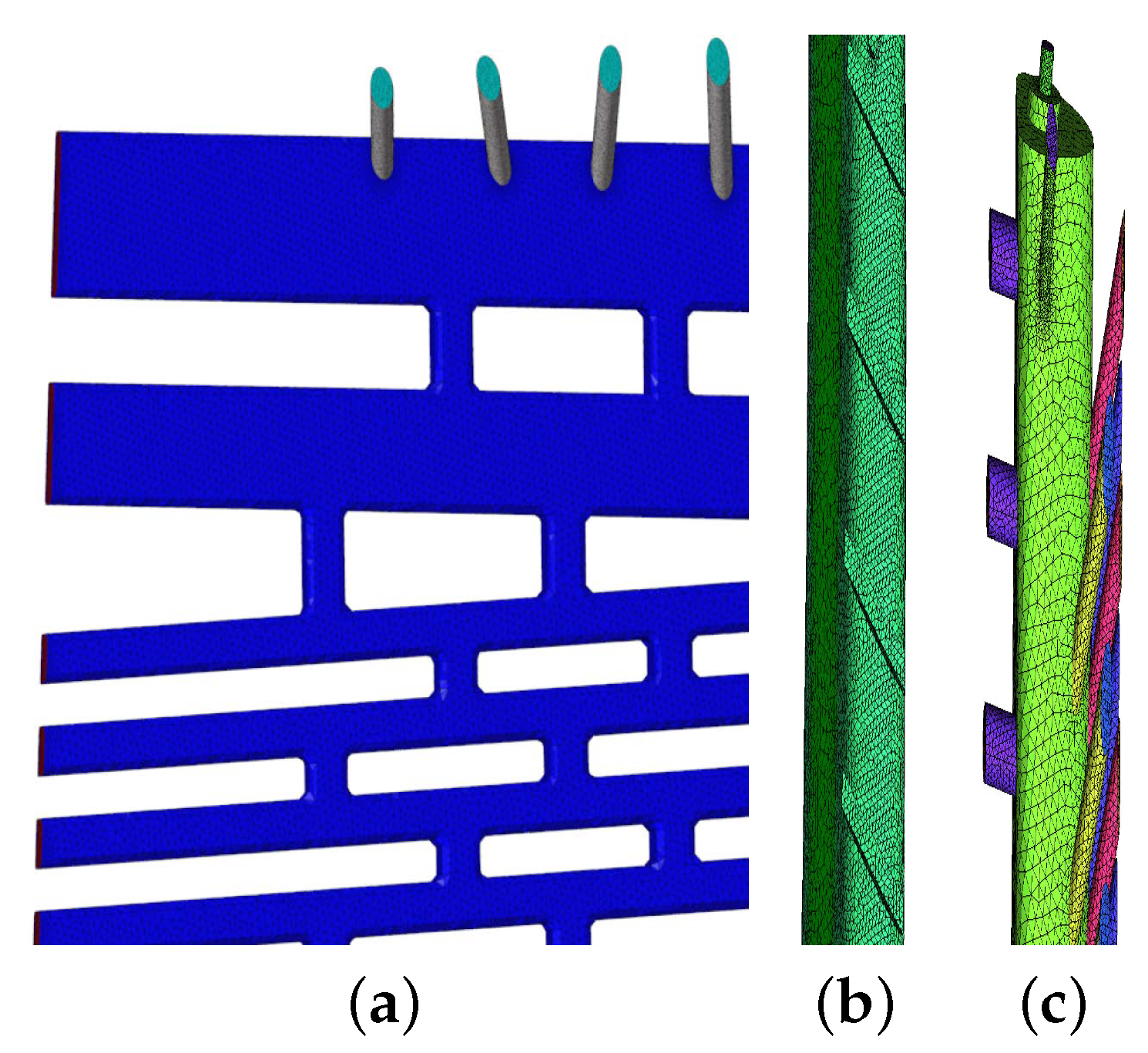
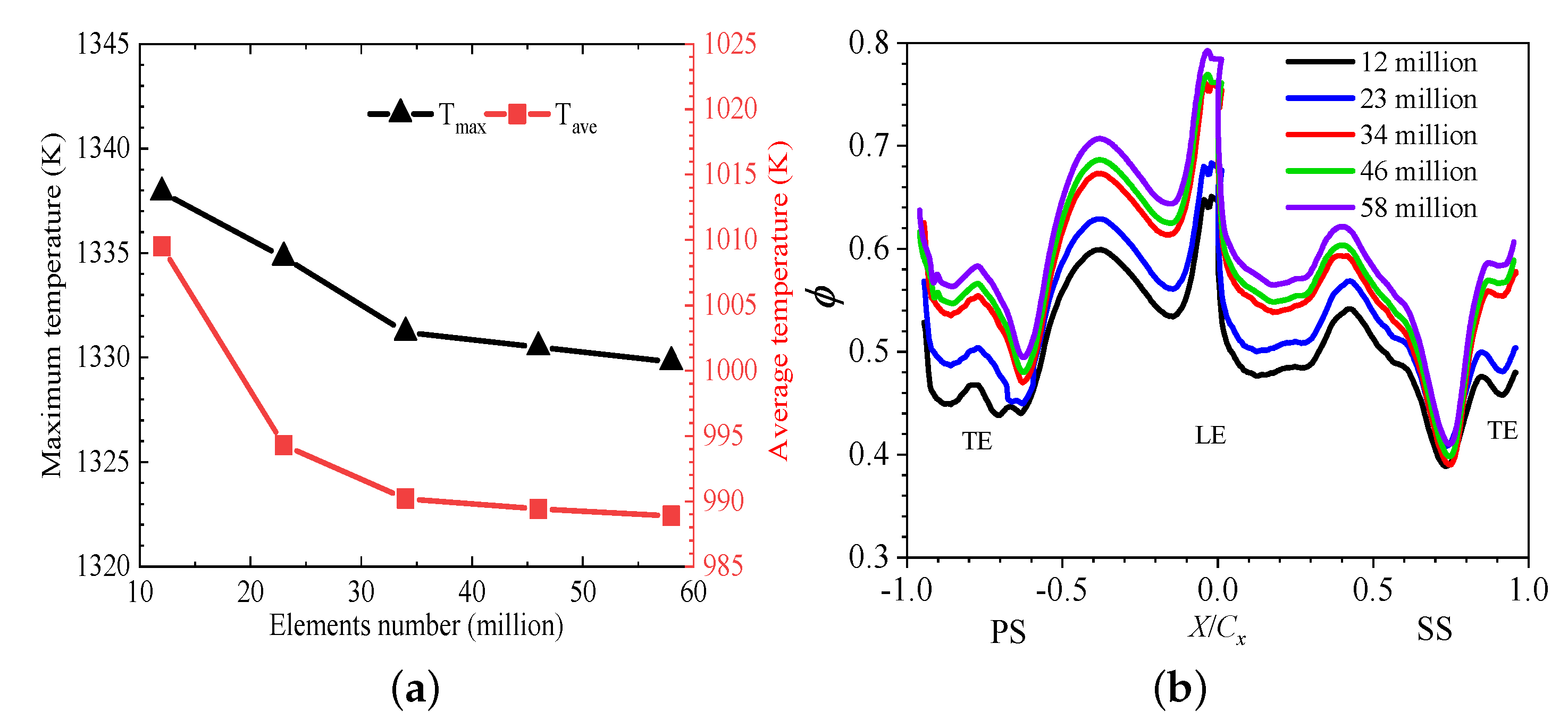
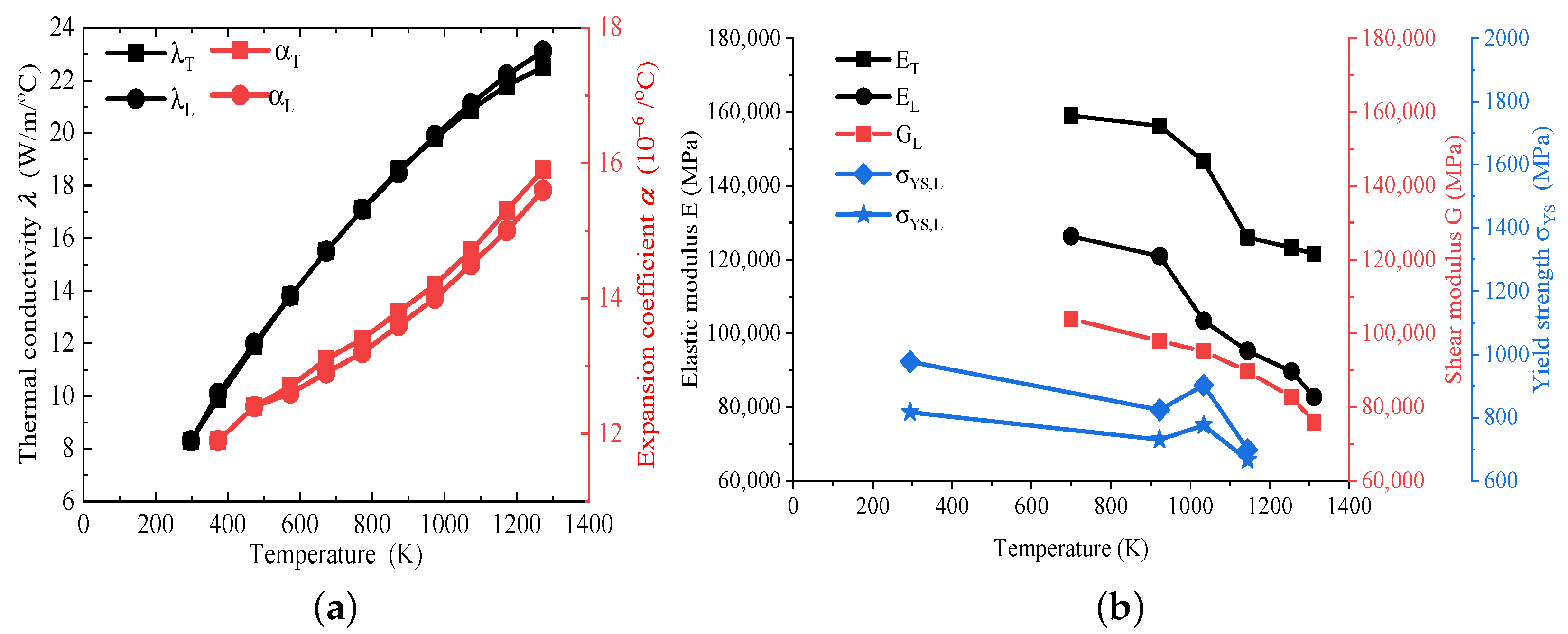


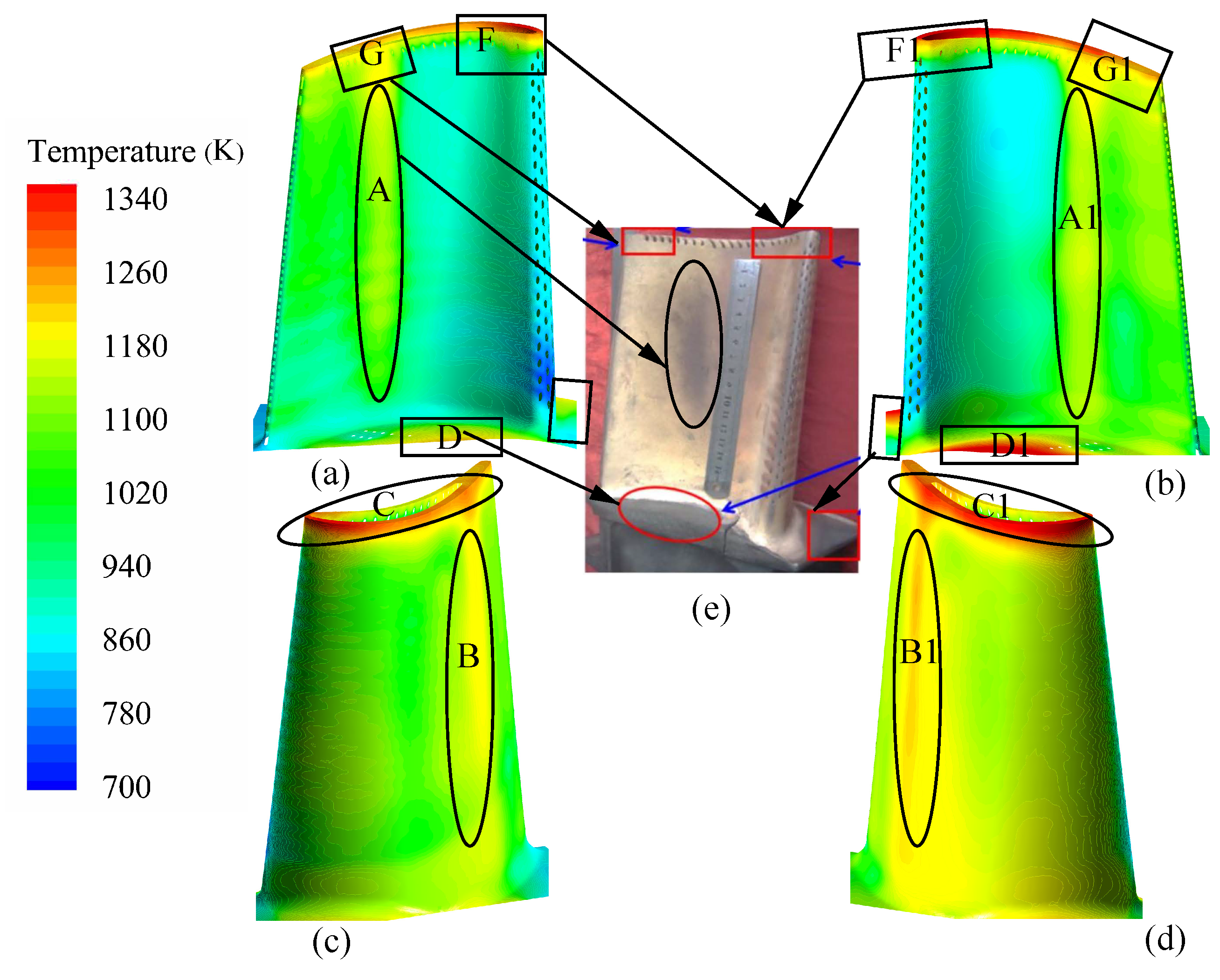
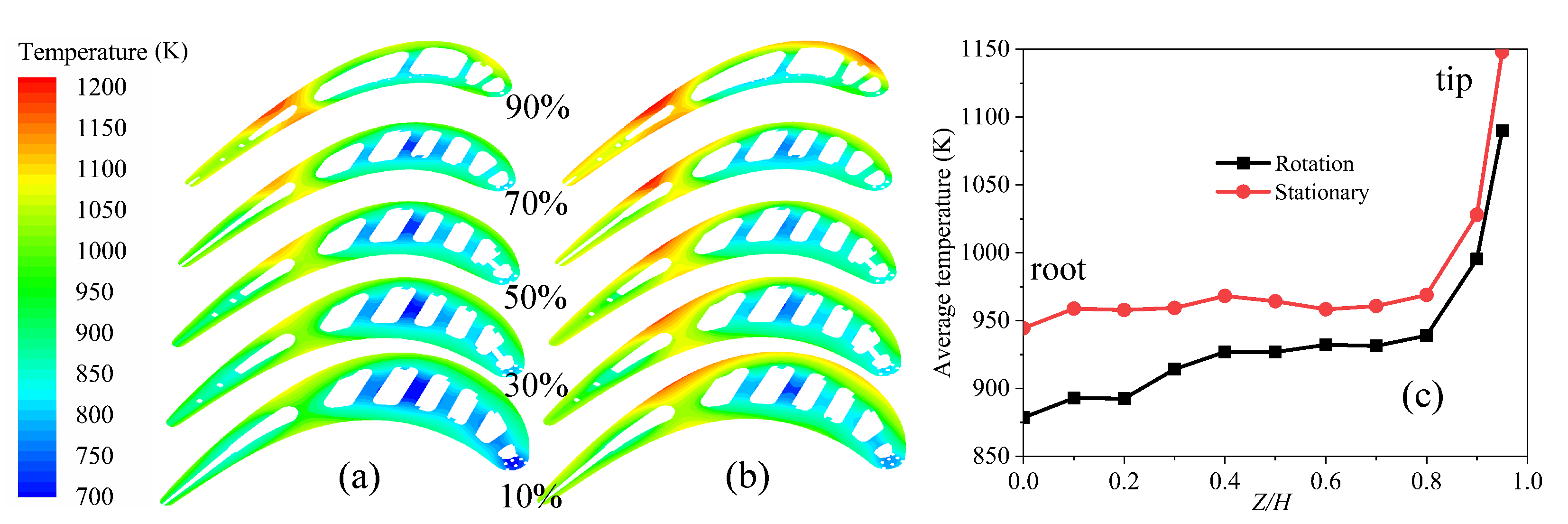

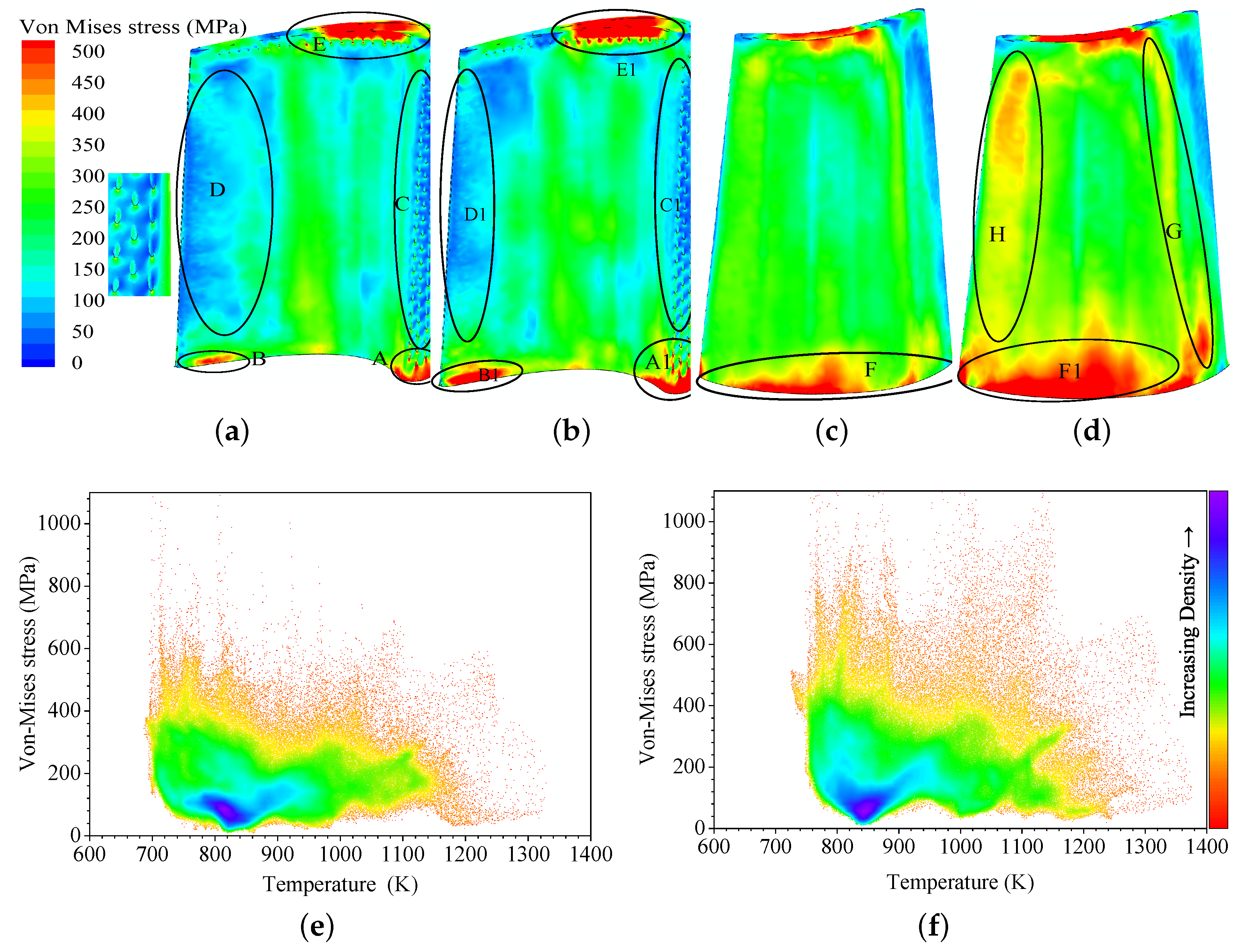

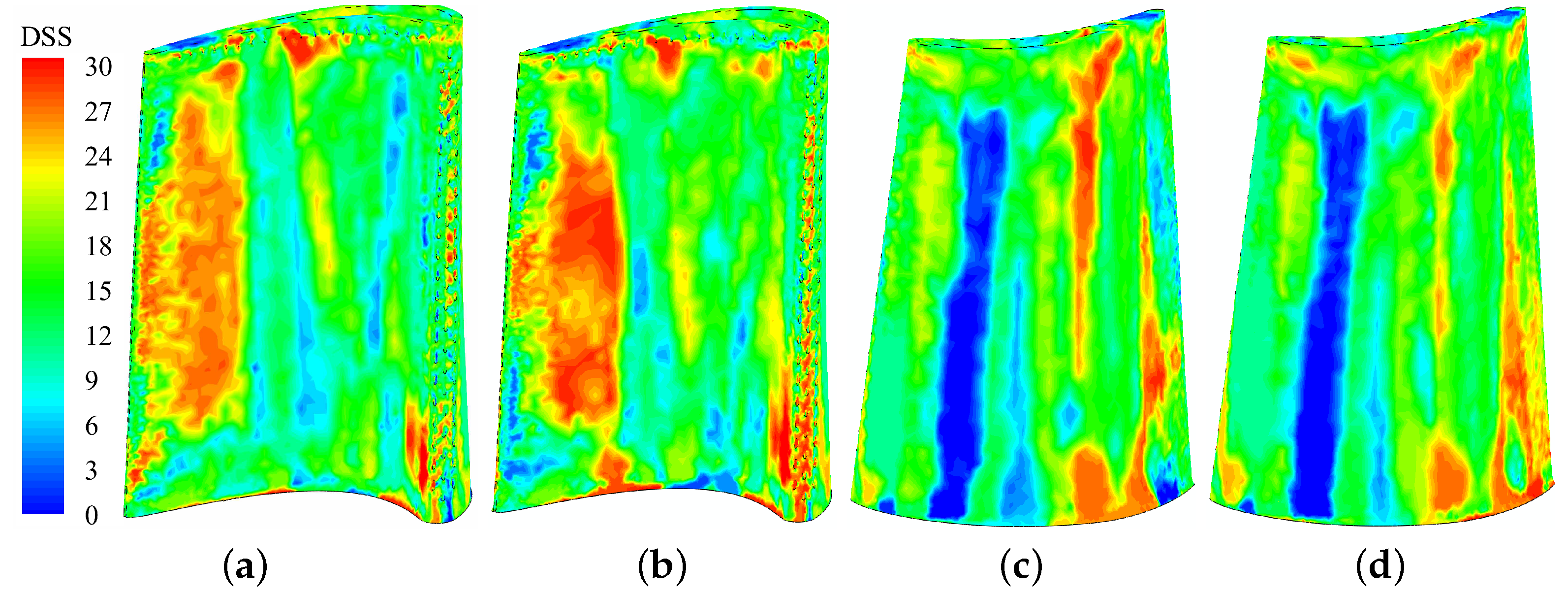
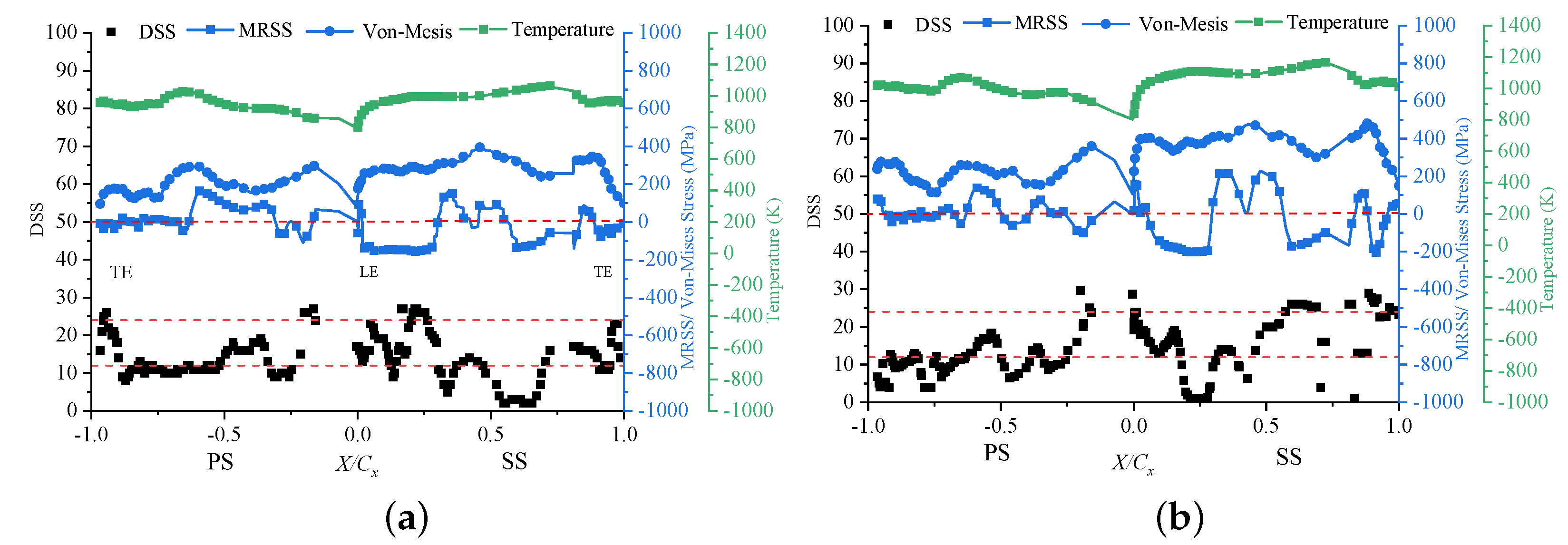

| Rotating | (Relative) | 1461 (Relative) | 657 | 657 | ||
| Stationary | 1471 | 657 | 657 |
Publisher’s Note: MDPI stays neutral with regard to jurisdictional claims in published maps and institutional affiliations. |
© 2022 by the authors. Licensee MDPI, Basel, Switzerland. This article is an open access article distributed under the terms and conditions of the Creative Commons Attribution (CC BY) license (https://creativecommons.org/licenses/by/4.0/).
Share and Cite
Qian, X.; Yan, P.; Wang, X.; Han, W. Numerical Analysis of Conjugated Heat Transfer and Thermal Stress Distributions in a High-Temperature Ni-Based Superalloy Turbine Rotor Blade. Energies 2022, 15, 4972. https://doi.org/10.3390/en15144972
Qian X, Yan P, Wang X, Han W. Numerical Analysis of Conjugated Heat Transfer and Thermal Stress Distributions in a High-Temperature Ni-Based Superalloy Turbine Rotor Blade. Energies. 2022; 15(14):4972. https://doi.org/10.3390/en15144972
Chicago/Turabian StyleQian, Xiaoru, Peigang Yan, Xiangfeng Wang, and Wanjin Han. 2022. "Numerical Analysis of Conjugated Heat Transfer and Thermal Stress Distributions in a High-Temperature Ni-Based Superalloy Turbine Rotor Blade" Energies 15, no. 14: 4972. https://doi.org/10.3390/en15144972
APA StyleQian, X., Yan, P., Wang, X., & Han, W. (2022). Numerical Analysis of Conjugated Heat Transfer and Thermal Stress Distributions in a High-Temperature Ni-Based Superalloy Turbine Rotor Blade. Energies, 15(14), 4972. https://doi.org/10.3390/en15144972





